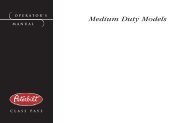Peterbilt Medium Duty Truck Owner's Manual - Peterbilt Motors
Peterbilt Medium Duty Truck Owner's Manual - Peterbilt Motors
Peterbilt Medium Duty Truck Owner's Manual - Peterbilt Motors
You also want an ePaper? Increase the reach of your titles
YUMPU automatically turns print PDFs into web optimized ePapers that Google loves.
VEHICLE RECOVERY AND SPRING BRAKES<br />
2. Into the inter-axle differential, add 2 pints (.94 liter) of<br />
approved lubricant.<br />
• See “Recommended Lubrication Types,” Page<br />
136.<br />
3. After adding the specified type and amount of lubricant,<br />
drive the vehicle. It should be unloaded. Drive 1<br />
to 2 miles (1.5 to 3 km) at a speed lower than 25 mph<br />
(40 km/h). This will thoroughly circulate the lubricant<br />
through the assembly.<br />
Spring Brakes — <strong>Manual</strong> Release<br />
In order to tow a vehicle, if there is insufficient air to<br />
release the parking brake, the spring brakes can be manually<br />
released.<br />
WARNING! Do not drive vehicle with malfunctioning<br />
brakes. If one of the brake circuits<br />
should become inoperative, braking distances<br />
will increase substantially and handling<br />
characteristics while braking will be<br />
affected. You could lose control of your vehicle<br />
and cause an accident resulting in death<br />
or personal injury. Have it towed to the nearest<br />
dealer or qualified workshop for repair.<br />
STARTING AND OPERATING THE VEHICLE<br />
You may sometimes have to release your vehicle's spring<br />
brakes by hand. This could happen if the system air pressure<br />
does not reach operating pressure because your<br />
engine or compressor is not working properly. You will<br />
have to release the spring brakes at the spring brake<br />
chambers.<br />
WARNING! Do not disassemble a spring brake<br />
chamber. These chambers contain a powerful<br />
spring that is compressed. Sudden release of<br />
this spring can cause death or personal<br />
injury.<br />
• Do not operate a vehicle when the spring<br />
brakes have been manually released. Driving<br />
a vehicle after its spring brakes are<br />
manually released is extremely dangerous.<br />
You will probably have no brakes at all. You<br />
could have a serious or fatal accident.<br />
• Releasing the spring brakes on an unsecured<br />
vehicle could lead to an accident. The<br />
vehicle could roll, causing severe injury.<br />
Always secure the vehicle with wheel<br />
chocks, chains, or other safe means to prevent<br />
rolling before manually releasing the<br />
spring brakes.<br />
– 142 – Y53-6027 <strong>Medium</strong> <strong>Duty</strong> (R05/09)
















